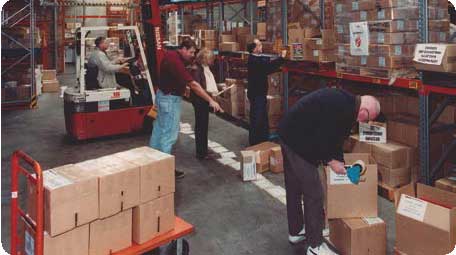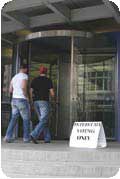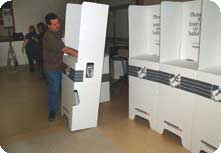Polling Arrangements
In this Section:
- Printing of ballot papers
- Training
- Pre-poll and postal voting
- Overseas voting
- Mobile polling
- Antarctic voting
- Infrastructure logistics
- Voting equipment
- Special sporting and cultural events
Related Results:
The AEC undertakes constant election preparations so that it is ready to conduct a federal election whenever it is announced. At the conclusion of one election the AEC reviews the conduct of that event and begins planning and preparing for the next election. There are, however, a large number of tasks which must be completed before election day that can only be commenced once the election is announced. These tasks involve organising a large quantity of materials, infrastructure and people all around Australia and overseas.
Printing of ballot papers
The AEC commenced printing the ballot papers on the Friday night following the draws for ballot paper positions.
For the 2004 federal election:
- approximately 40.6 million ballot papers were printed
- approximately 290 tonnes of paper were used to print the papers.
The AEC is required to account for every ballot paper from the time they are printed until they are no longer required. Strict security surrounds the printing, handling and storage of ballot papers to ensure the integrity of the electoral process.
Camera ready artwork of the ballot papers was produced directly from the AEC’s computerised nominations system. The House of Representatives ballot papers were produced in a numbered cheque-book style pad which enabled easier handling and enhanced accountability.
In the week beginning 20 September 2004, ballot papers were distributed to the 150 AEC divisional offices around Australia. On receipt of the ballot papers, the DROs counted them and securely stored the majority in readiness for election day. A number of the ballot papers were to be used before election day for conducting pre-poll, mobile and postal voting.
The AEC also distributed some 117 100 House of Representatives and some 104 600 Senate ballot papers to 100 Australian embassies, high commissions and consulates, to enable Australians overseas to vote.

Election materials are distributed across Australia
The total number of ballot papers (excluding those used for postal and overseas votes) printed for each State and Territory was as follows:
| State/Territory | Senate | House of Representatives |
|---|---|---|
| NSW | 5 389 700 | 7 896 500 |
| VIC | 4 358 000 | 6 708 000 |
| QLD | 2 963 300 | 4 039 280 |
| WA | 1 662 000 | 2 308 050 |
| SA | 1 331 100 | 1 859 350 |
| TAS | 454 000 | 543 600 |
| ACT | 343 100 | 318 900 |
| NT | 200 000 | 200 000 |
| TOTAL | 16 701 200 | 23 873 680 |
At the 2004 election an automated postal vote system was used to print an additional 762 206 House of Representatives ballot papers. 1 022 686 additional Senate ballot papers were printed separately to be used for postal voting.
Training
The AEC requires a large number of trained staff, both permanent and temporary, to assist eligible Australians to cast their vote. At the announcement of an election each DRO has the responsibility of recruiting and training the polling officials required for their division.
Training for polling officials is conducted to ensure that the voting and the scrutiny (the counting of votes) are carried out efficiently and professionally in accordance with the Act.
Over the conduct of numerous elections the AEC has developed and fine-tuned a training package for polling officials which includes manuals and practical exercises. Some polling officials are also required to attend presentations conducted by the DRO or other AEC staff members. Many election staff have worked at a number of elections, building up extensive experience.
At the 2004 election:
- approximately 67 000 temporary staff assisted in the conduct of the election
- 74 400 copies of training CD ROMs were produced
- over 74 000 manuals were printed
- 450 call centre operators were trained to answer inquiries.
Pre-poll and postal voting

Voters go to an interstate voting centre in Hobart
To enable as many eligible electors as possible to cast a vote the AEC provided a number of alternative arrangements for voting. Electors unable to vote on election day were able to cast a vote before election day at a pre-poll voting centre or could apply to vote by post.
Pre-poll Voting
For this election 309 pre-poll voting centres were set up:
- in all capital cities
- in major regional centres in each electoral division
- in remote areas of Australia
- at airports around the country for Australians travelling interstate or overseas
- for defence personnel
- at special sporting and cultural events.
Postal Voting
Electors who had difficulty getting to a polling place were able to apply for a postal vote. Postal vote application forms were available from AEC offices and post offices. The ballot papers were then sent out by the AEC to the elector at their nominated address anywhere within and outside Australia. Electors voting by post had to have their completed ballot papers in the mail to the AEC before election day and under electoral law, the AEC waited up to 13 days after election day for postal votes to be received. Electors with a disability, silent electors, prisoners, those in remote areas, and people who have religious objections to attending a polling place on election day can apply to become a General Postal Voter (GPV). This means that for future federal elections they will be automatically sent out their ballot papers.
A record number of almost 760 000 postal votes were issued for the 2004 federal election. A significant administrative issue for the AEC arising out of Election 2004 related to the delay in processing some postal vote packages to voters. As soon as problems were identified steps were taken to ensure that electors affected were still able to vote. After the election the AEC contracted Minter Ellison to conduct an inquiry into postal voting at the election. Minter Ellison has made recommendations to the AEC identifying ways to help improve postal voting procedures for the next electoral event.
Overseas voting
The opportunity for eligible Australians living, working or holidaying overseas to vote has become an important part of a federal election. Australians overseas during the 2004 federal election were able to cast their vote at 100 overseas voting posts in the two weeks leading up to election day. They were able to visit their nearest Australian Embassy, consulate or high commission and vote in person.
At the 2004 federal election:
- there were 100 overseas posts in 75 countries at which Australians could vote
- a total of 68 544 votes were issued overseas
- the most votes, 20 716, were issued in London.
For a full list of votes issued overseas refer to Appendix B.
Mobile polling
AEC mobile polling teams take portable polling places to many electors who are not able to get to a polling place. Mobile polling was carried out around Australia during the 12 days before election day and on election day.
Hospitals and Nursing Homes
Mobile polling teams visited selected hospitals and nursing homes to enable patients and residents to cast their vote. The teams provided a personal service by bringing the ballot papers, ballot box and other information to electors who were elderly or unable to leave their beds. At the 2004 federal election, 2 107 hospitals and nursing homes around Australia were visited by a total of 445 mobile polling teams in the days leading up to and including election day.
Prisons
Mobile polling teams also visited a small number of prisons and remand centres to take the votes of prisoners serving a sentence of three years or less who were entitled to vote. At the 2004 federal election, 17 mobile polling teams visited 21 prisons and remand centres in the five days leading up to election day. The majority of eligible electors serving a prison sentence voted by post.
Remote Mobile Polling
Geographic remoteness was no barrier to helping electors cast their vote in the 2004 federal election. Mobile polling teams visited electors living in remote locations in the 12 days leading up to and including election day. The AEC used road, air and sea transport to visit Aboriginal and Torres Strait Islander communities and their outstations, pastoral properties, small towns, tourist resorts and mine sites. A number of local Aboriginal and Torres Strait Islander people were recruited to identify, interpret for and assist with the special needs of electors at many remote mobile polling locations. At the 2004 election, 43 mobile polling teams visited 382 remote locations in the Northern Territory (Division of Lingiari), Western Australia (Division of Kalgoorlie), South Australia (Divisions of Grey and Barker) and Queensland (Division of Leichhardt).
In the Division of Lingiari:
- 20 teams visited 259 locations in the 12 days before election day. 47 of these locations were also established as interstate voting centres whereby electors enrolled interstate could also cast their votes. Two of the teams also visited 13 locations in South Australia (Division of Grey). These locations were also established as interstate voting centres.
- The 60 interstate voting centres organised by the Northern Territory provided opportunities for an additional 400 electors to cast their votes from remote locations. For some of these electors, it was the first time they had been able to cast their vote in person, rather than using postal votes.
- Teams commenced polling on 27 September, with the first polling location at Wallace Rockhole in Central Australia.
- Teams used four wheel drives, fixed wing aircraft and helicopters for transport.
In the Division of Kalgoorlie:
- 14 teams visited 52 locations in the 12 days before election day
- The division is the largest in Australia covering an area of 2 295 354 square kilometres. Due to its size, remote polling was organised from the division’s two permanent offices in Kalgoorlie and Karratha
- the teams used planes and four-wheel drives for transport.
In the Division of Leichhardt:
- 3 mobile teams visited 19 remote locations in the five days before election day
- teams used planes, helicopters, water taxis and four-wheel drive vehicles for transport
- the visits were advertised through posters, newspaper, radio, television and letters sent to community organisations.
In the Division of Grey:
- 5 teams visited 36 communities
- teams used four wheel drive vehicles and fixed wing aircraft for transport
- 13 locations in the Anangu Pitjantjatjara Lands and Far North of SA near the Northern Territory border were serviced by two teams operating out of the Northern Territory.
In the Division of Barker:
- 1 mobile team visited 3 locations in the two days prior to election day.
Antarctic voting
Working and living in one of the most challenging locations in the world did not prevent a group of Australian electors stationed in the Antarctic from voting in the 2004 federal election. A total of 63 eligible electors were living at Australia’s Antarctic research bases at Mawson, Casey and Davis and on sub-Antarctic Macquarie Island during the election. Ballot papers were faxed to Antarctica by the AEC’s Hobart office. At each base an Antarctic Returning Officer was appointed from the staff and polling could take place at any time once the materials were received at the bases. After the close of polls each Antarctic Returning Officer phoned the results through to the AEC’s Hobart office. Their votes were transcribed onto normal ballot papers and despatched to the electors’ home divisions. The originals filled out by Antarctic electors were packaged up and returned to Hobart on the first available supply ship.
Voting is not compulsory for Antarctic electors as the secrecy of the vote cannot be assured, because of the process used to transmit the results. At this election, 60 votes were recorded in the Antarctic, compared with 88 votes in 2001.
Infrastructure logistics
| Number of ordinary polling places | 7 729 |
| Number of mobile teams who visited special hospitals | 445 |
| Number of locations visited | 2 107 |
| Number of mobile teams who visited remote outback locations | 43 |
| Number of locations visited | 382 |
| Number of mobile teams who visited prisons | 17 |
| Number of locations visited | 21 |
| Number of pre-poll voting centres | 309 |
| Number of overseas polling places | 100 |
Voting equipment
A large amount of cardboard equipment and paper materials are produced for each federal election. Whenever possible, the AEC uses cardboard and paper equipment manufactured from recycled materials that are in turn recyclable or reusable.
At the 2004 federal election over 237 900 separate pieces of equipment were produced.
This equipment included:

Voting screens are packed away to be used at the next electoral event
| Item | Quantity |
|---|---|
| Ballot boxes | 45 505 |
| Voting screens | 150 599 |
| Queuing signs | 10 462 |
| Recycling bins | 13 893 |
| Tables | 6 875 |
| Item | Quantity |
|---|---|
| Postal vote envelopes | 952 559 |
| Declaration vote envelopes | 3 456 000 |
Special sporting and cultural events
At the 2004 federal election, there were a number of sporting and cultural events happening on election day or over the election weekend. While the message to electors was to ‘vote before you go’ the AEC did provide additional resources to cater for the electors at many of these events. This included opening additional polling places for both local and interstate electors in the lead up to and on election day and increasing staffing levels at other polling places.
Some of the events where additional resources were provided included:
- Sydney Motor Show at Darling Harbour NSW
- Bathurst V8 race at Mount Panorama NSW
- Cardross Spring Flower Show VIC
- Koondrook Bridge Centenary VIC
- Manangatang Race meeting VIC
- Rainbow Rainbow Centenary VIC
- Warracknabeal School reunion VIC
- Melbourne to Warnambool bike race VIC
- Kyneton Jazz Festival VIC
- Farmers Market in Bendigo VIC
- Uncorked Festival in Bendigo VIC
- National Women’s Hockey tournament at Curtin University WA
- Spring in the Valley Festival (approximately 35 000 visitors through the Swan Valley wine growing region) WA
- Glendambo Gymkhana (SA)
- The Burra Show (SA)
- Port Elliott Show (SA)
